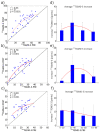Motor Competence in Individuals with Down Syndrome: Is an Improvement Still Possible in Adulthood?
- PMID: 35206339
- PMCID: PMC8872009
- DOI: 10.3390/ijerph19042157
Motor Competence in Individuals with Down Syndrome: Is an Improvement Still Possible in Adulthood?
Abstract
In children, motor competence (MC) and the amount of physical activity are tightly interconnected. In adults with Down syndrome (DS), MC has been poorly addressed, resulting in a limited understanding of the possibility to improve MC over time. Here, we aim to: (1) investigate MC in adults with DS by comparing them with a group of typically developed peers and (2) verify the effect of an adapted karate program on MC. Adults with DS (DSG; n = 57) and typically developed adults (TDG; n = 21) performed the Test of Gross Motor Development version 3 (TGMD-3). The total TGMD-3 score (TOTTGMD-3), the locomotor (LOCTGMD-3), and object control (OBJTGMD-3) scores were computed. After a 40 week adapted karate program, DSG (n = 37) underwent the post-training TGMD-3 assessment. Compared to TDG, DSG showed lower TOTTGMD-3 (DSG: 45.5 ± 17.3; TDG: 77.3 ± 9.5), LOCTGMD-3 (DSG: 22.2 ± 10.0; TDG: 36.2 ± 7.6) and OBJTGMD-3 (DSG: 23.3 ± 10.9; TDG: 41.1 ± 5.6). After the training, TOTTGMD-3, LOCTGMD-3 and OBJTGMD-3 increased by 35.6%, 30.0% and 40.7%, respectively. Our results suggest that MC acquisition does not evolve into a mature form in adulthood in individuals with DS. Moreover, a brief exposure to an adapted karate program induces an increase in motor competence in DS, even in adulthood.
Keywords: TGMD-3; adapted training; karate; motor development; physical activity; skill assessment.
Conflict of interest statement
The authors declare no conflict of interest.
Figures




References
-
- Bardid F., Vannozzi G., Logan S.W., Hardy L.L., Barnett L.M. A hitchhiker’s guide to assessing young people’s motor competence: Deciding what method to use. J. Sci. Med. Sport. 2019;22:311–318. - PubMed
-
- Seefeldt V. Developmental motor patterns: Implications for elementary school physical education. In: Nadeau C., Holliwell W., Newell K., Roberts G., editors. Psychology of Motor Behavior and Sport. Human Kinetics; Champaign, IL, USA: 1980. pp. 314–323.
-
- Stodden D.F., Goodway J.D. The Dynamic Association Between Motor Skill Development and Physical Activity. J. Phys. Educ. Recreat. Danc. 2007;78:33–49. doi: 10.1080/07303084.2007.10598077. - DOI
Publication types
MeSH terms
LinkOut - more resources
Full Text Sources
Medical

